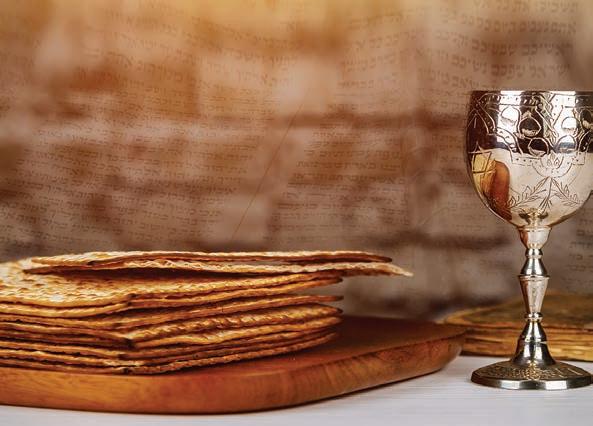
3 minute read
Chag atis adeesdzá bééhániih sameach to one and all
2) Not all Israeli wines are kosher. Only about 30% of Israeli wine brands are certified kosher but these kosher wineries produce over 90% of the Israeli wine industry’s output.
3) In the 1980s, there were very few kosher wines. Buchsbaum said that Royal Wine only imported three kosher wines from Bordeaux, France, at that time.
Advertisement
f you’d like to change up your Passover greeting this year, you could try it in Navajo. That would be atis adeesdzá bééhániih — Passover in Navajo — as it appears in a calendar published annually showcasing Navajo and Hopi artists by the Flagstaff-based publishing house Salina Bookshelf, Inc.
I4) The number of producers of kosher wines has dramatically increased in the past 10 to 20 years. This is due to an increase in interest from consumers who are adding to their kosher wine portfolios and in some cases building actual kosher wine cellars in their homes, a rare sight just two decades ago.
5) While several well-known wineries in countries from all over the world including France, Spain, Italy and Argentina are crafting special runs of kosher wine, California is not. Except for Marciano Estate, which produces a kosher run of their Terra Gratia, a high-end Napa Valley Blend, all kosher California wine is made by fully kosher wineries such as Herzog Wine Cellars, Covenant and Hagafen.
“It’s is in the 2022 calendar and we have been including it for quite a few years now,” Mitchell said about Passover. “We have Christian holidays and Navajo Nation Treaty Day, which commemorates the Treaty of 1868 on June 1 every year.”
For the Navajo (Diné), the 1868 Treaty allowed a return to their ancestral homelands (Dinétah) and is an important symbol of Navajo sovereignty, according to the Smithsonian National Museum of the American Indian.
6) The reason many Passover dinners feature red wine is because there’s a rabbinic opinion that red wine is preferable since it’s the same variety that Jews used during their seders after they escaped Egypt.
7) Kosher wines can range in price from $5 a bottle to $500. The average price for a bottle of good kosher wine is $25.
“It’s an important holiday that commemorates when the U.S. government allowed the tribes to return to their homelands after having been displaced in ‘the Long Walk,’” Mitchell said.
8) The most popular Moscato in the United States happens to be kosher. Bartenura produces the largest-selling imported Italian Moscato in the U.S. The Moscato in the famous blue bottle sells over 5,000,000 bottles annually, only a fraction of which to the kosher market.
Salina Bookshelf, founded in 1994, is an independent publisher of multicultural materials which includes textbooks, children’s picture books, children’s chapter books, informational texts, reference books, audiobooks and language learning materials. They specialize in dual language books in Navajo/English and Hopi/ English and textbooks used to teach the Navajo language in schools.
Passover has been included in the calendar for several years, stated Tyler Mitchell, executive editor at Salina. However, he’s not exactly sure when it was initially added or who translated the word for the holiday into Navajo.
As far as he knows, Passover is the only Jewish holiday in their calendar.
9) Currently, there is a steady increase in total wine consumption and a great interest specifically in high-end Israeli wines, as well as the better French wines.
“When we do our calendar, we find a list of holidays on the internet, include some of them and give Navajo names to them,” he said.
10) Drinking wine can be a mitzvah. Kosher wine is prescribed for use in many Jewish rituals: at a brit milah, a pacifier dipped in wine is used to comfort the baby during circumcision; under the wedding chuppah, when the bride and groom officially become a couple; and the Kiddush that starts all Sabbath and holiday meals. While most occasions call for just one cup, on the holiday of Purim, wine (in abundance) is the beverage of choice for the festive meal, recalling wine’s significant role in the “banquets” described in the Megillah story. And on Passover, Jews are required to drink four cups of wine at the seder. JN
For more information, visit royalwine.com.
Navajo is the third most spoken language in Arizona, after English and Spanish. According to “Ethnologue: Languages of the World,” the Navajo language has 7,600 monolingual speakers and more than 170,000 fluent speakers worldwide. There are some slight regional variations in pronunciation and vocabulary among the language spoken in Arizona, New Mexico and Utah.
For the past several years, Albuquerque, N.M. resident Dr. Gordon Bronitsky, who received his Ph.D. in anthropology from the University of Arizona in 1977, has worked promoting indigenous artisans. He has extensively studied Native American history and is an expert on Native AmericanJewish relations, having worked on cultural diplomacy with the state department.
Bronitsky discovered the unique calendar and broke down the translation of atis









